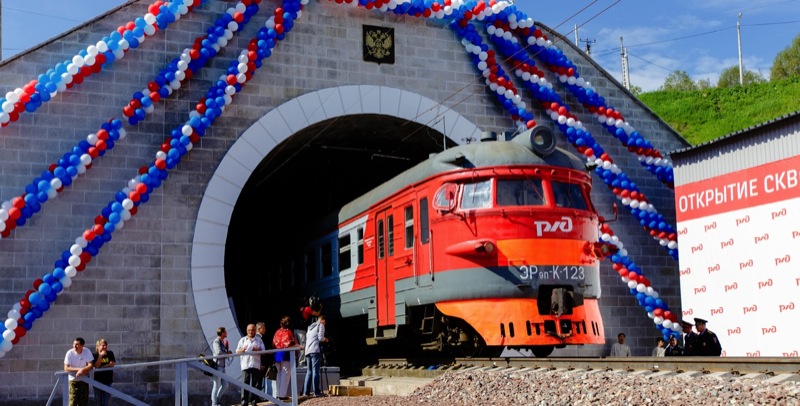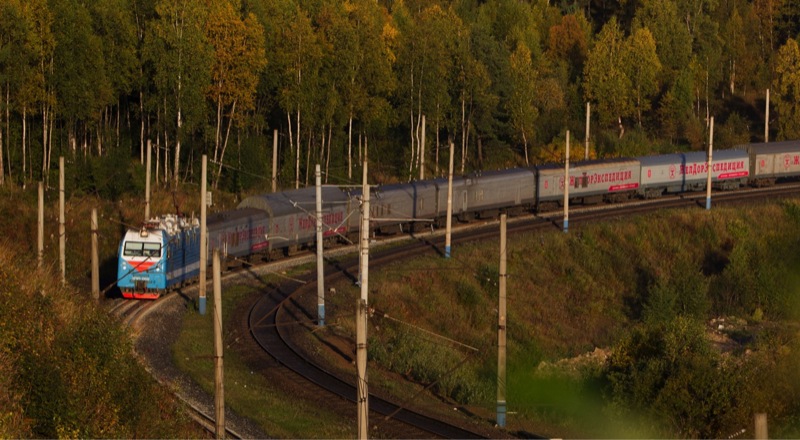Projects involving the renovation and maintenance of railway infrastructure.
Funded by the Company through its own cash flow and depreciation.
The Russian Railways investment programme was compiled based on the General Development Plan for Railways until 2020 for which the cargo base is established taking into account applications received by shipping companies.
Infrastructure bonds were placed in 2014 for a total of RUB 50 bln
Estimates of the cargo base take into account the available forecasts and benchmarks contained in government and regional strategic documents as well as data from international organisations and institutions (the International Monetary Fund and World Bank, among others) and leading research organisations (both national and international).
The forecast also takes into account plans to develop related types of transportation, the plans of individual stevedore organisations at Russian ports and the development programmes and strategies of the constituent entities of the Russian Federation.
The development of an economic transportation model or interregional input-output model for freight shipments significantly helped to improve the forecasting quality of the cargo base. Russian Railways performed this work jointly with industry-based research institutions: the Institute of Economic Forecasting under the Russian Academy of Sciences and the Council for the Study of Productive Forces.
When putting together its investment programme, Russian Railways employed the principle of coherent funding sources and an investment programme structure, which aims for:
All Russian Railways investment projects are separated into four categories based on the payback period and commercial effectiveness.
Russian Railways placed infrastructure bonds worth a total of RUB 50 bln in 2014.
The funds earned from the infrastructure bonds were spent on the purchase of traction rolling stock and to implement projects for the comprehensive development and reconstruction of railway infrastructure on approaches to ports in northwest and southern Russia as well as the Urals, West Siberia and the Far East, including the reconstruction of the Trubnaya-Baskunchak-Aksarayskaya sections and the development of the railway infrastructure of the Baikal-Amur Mainline.
These projects have payback periods of up to 30 years with a significant multiplier effect for the Russian economy.

The Company continued the practice of conducting an independent technology and price audit (TPA) of its investment projects in 2014 in accordance with the directives of the Russian Government.
The introduction of the PPA procedure as initiated by the Russian Government was an important step towards improving the openness and transparency of the Company’s investment programmes that are funded in full or in part by federal budget funds.
In 2013, the Company developed the Corporate Standard ‘Mandatory Technology and Price Audit of the Investment Projects of Russian Railways and its Subsidiaries and Affiliates’ (hereinafter the Corporate Standard), which was approved by the Russian Railways Board of Directors.
Taking into account the instructions of the Russian Government as well as the procedure specified in the Corporate Standard, measures were implemented to conduct PPAs of railway infrastructure development projects at approaches to ports in the Azov and Black Seas, including the project ‘Comprehensive reconstruction of the M. Gorky-Kotelnikovo-Tikhoretskaya section with a bypass of the Krasnodar Railway Hub’ and projects to rebuild and modernise the Baikal-Amur and Trans-Siberian Mainlines as well as the Mezhdurechensk-Tayshet section.
The results of the PPAs are published on the official website of Russian Railways in accordance with the Corporate Standard in order to arrange expert discussions.
An expert discussion on the projects to rebuild and modernise the Baikal-Amur and Trans-Siberian Mainlines was held on 23 January 2014.
An expert discussion on the project to develop approaches to ports in the Azov and Black Seas, including the project ‘Comprehensive reconstruction of the M. Gorky-Kotelnikovo-Tikhoretskaya section with a bypass of the Krasnodar Railway Hub’ was held on 27 February 2015.
Proposals and suggestions were prepared during the expert discussions and also based on additional work with the Expert Council under the Russian Government and analysed by the Company and auditors so they can be taken into account for the further implementation of projects.
Overall, the experts noted that the projects have been sufficiently studied given the current implementation stage.

The main objective of the Russian Railways investment programme is to develop and maintain railway infrastructure at the proper level and ensure the safety and sustainability of the transportation process as well as operational reliability.
The overall investment budget in 2014 totalled (actual execution) RUB 396 bln Spending amounted to 99.8% of the plan
Investment related to the fulfilment of the Russian Government’s instructions in 2014 totalled RUB 67.5 bln
Investment on renovating rolling stock in 2014 totalled RUB 104.4 bln
Investment on the elimination of infrastructural constraints in 2014 totalled RUB 140.8 bln
Tracks modernised in 2014
3.95
thousand km
New stationary tracks put into operation in 2014 73.6 km
A substantial portion of funds are spent on renovations to rolling stock, supporting occupational, environmental and fire safety conditions and refurbishing worn high-risk facilities.
Investment expenditures of RUB 396.8 bln were planned in 2014 from the following financial sources:
Given the challenging economic environment in which the Company worked in 2014, 99.8% of the plan was implemented and the total amount of investment expenditures came to RUB 396.0 bln.
| Section | 2013 | 2014 | +/— 2014 vs 2013 | % 2014 vs 2013 | ||||
|---|---|---|---|---|---|---|---|---|
| Actual | Share of total expenditures | Target | Actual | Share of total expenditures | % | |||
| TOTAL | 467.2 | 100 | 396.8 | 396.0 | 100.0 | 99.8 | –71.2 | 84.8 |
| Projects related to the fulfilment of the Russian Government’s instructions | 46 | 9.8 | 68.2 | 67.5 | 17.1 | 99.1 | 21.6 | 147.0 |
| Safety | 56.1 | 12.0 | 46.7 | 46.9 | 11.8 | 100.4 | –9.2 | 83.6 |
| Eliminating infrastructural constraints | 169 | 36.2 | 140.5 | 140.8 | 35.6 | 100.2 | –28.2 | 83.3 |
| Improving transportation accessibility for the public | 59.5 | 12.7 | 12.9 | 12.8 | 3.2 | 99.2 | –46.7 | 21.5 |
| Renovating rolling stock | 118.7 | 25.4 | 104.7 | 104.4 | 26.4 | 99.7 | –14.3 | 88.0 |
| Other projects | 17.8 | 3.8 | 23.8 | 23.6 | 6.0 | 99.2 | 5.8 | 132.6 |
The main objective within the execution of the Russian Railways investment budget in 2014 was to implement projects to fulfil the instructions of the Russian President and Russian Government, which accounted for 17% of the programme’s total volume, or RUB 67.5 bln. Projects as part of government instructions include:
The Company met all the targets set for 2014, including the implementation of projects involving the fulfilment of the instructions of the Russian Government.
The Company’s investments in 2014 were spent not only on developing infrastructure, but also on renovation projects that are essential to ensuring the sustainable and safe operation of railway transportation (reconstruction of railway tracks as well as the construction and reconstruction of engineering structures).
A total of RUB 46.9 bln were spent in 2014 on projects related to safety, including transportation safety, civil defence and fire safety as well as projects that aim to ensure the technological sustainability of the production process and maintain carrying capacity.
The Company spent RUB 140.8 bln on the elimination of infrastructural constraints in 2014, including those involving an increase in the carrying capacity of the railway network.
As part of the Elimination of Infrastructural Constraints section, a substantial amount of funds were spent on the implementation of projects that significantly affect the development of the Russian economy as a whole and aim to increase the carrying capacity of the railway network and also develop other transportation infrastructure (construction of additional mainlines, the extension of stationary receiving and departure tracks and the development of railway hubs).
A total of 3,950.8 km of railway tracks were reconstructed in 2014 as part of a project to rebuild railway tracks.
As part of the project ‘Reconstruction of engineering facilities’, the reconstruction of the Mansky Tunnel was completed on the Abakan-Tayshet section of Krasnoyarsk Railways in addition to 20 small and medium-sized railway bridges, 20 road bed facilities, three pedestrian bridges at the Kraskovo and Fruktovaya stations of Moscow Railways and the Demy station of Kuybyshev Railways.
A total of RUB 12.8 bln were spent on improvements to transportation accessibility for the public. Projects were implemented in 2014 to renovate the fixed assets of suburban and long-haul passenger transportation.
The reconstruction of railway facilities at the Rybinsk-Passenger and Ryazan–2 stations was completed in 2014.
As part of the Rolling Stock Renovation section, 660 locomotives were purchased in the reporting year for RUB 76.5 bln along with 283 railcar rolling stock for a total of RUB 19.3 bln, including 150 ED series electric trains produced by Demikhovsky Machine-Building Plant, 18 PA–2 series rail bus cars produced by Metrovagonmash, four Sapsan electric trains (40 railcars) and 15 Lastochka (Desiro RUS) electric trains (75 railcars) produced by Siemens AG.
A total of 603 railcar rolling stock and eight Sapsan trains were modernised for a total of RUB 845.9 mln.
The electric trains were equipped with modern air conditioning systems, sealed inter-car walkways, automatic sliding doors, LED lighting, seats with soft armrests and headrests, video surveillance systems, forced ventilation for railcars and a system for the onboard diagnostics and monitoring of the train’s technical condition, and work was also performed to install a security and fire alarm system.
A total of RUB 23.6 bln were spent on other projects involving scientific research and experimental design work, social development projects and contributions to the charter capital of other companies.
Overall, Russian Railways put the following into operation:
and rebuilt: